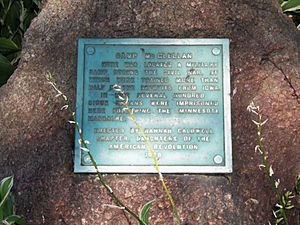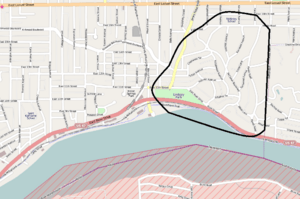Camp McClellan (Iowa) facts for kids
Quick facts for kids Camp McClellan |
|
|---|---|

Marker in Lindsay Park
|
|
| Location | Davenport, Iowa |
| Built | 1861 |
| Governing body | Private |
| Lua error in Module:Location_map at line 420: attempt to index field 'wikibase' (a nil value). | |
Camp McClellan was an important Union Army camp in Davenport, Iowa. It was set up in August 1861, right after the American Civil War began. The camp served as a training center for new soldiers. It also had a hospital for soldiers who were hurt or sick.
Later, in 1863, the camp changed. It became a prison camp called Camp Kearney. Here, members of the Sioux (also known as Dakota) tribe were held. They had been involved in a conflict in Minnesota. The camp closed down in 1866 after these prisoners were released.
Contents
Camp McClellan: A Civil War Training Ground
The land for Camp McClellan was very large, over 300 acres. It was owned by Thomas Russel Allen. The camp was built right across the Mississippi River from the Rock Island Arsenal. The Arsenal also held Confederate Army prisoners during the war.
Iowa's Adjutant General, Nathaniel B. Baker, moved his offices to Davenport. He created Camp McClellan to train volunteer soldiers. Lieutenant Colonel William Hall was in charge of setting up the camp. It was named after General George B. McClellan.
Building the Camp
Camp McClellan was the biggest of five camps in Davenport. About 40,000 Iowa soldiers trained there. This was almost half of all Iowa troops who fought in the war. Soldiers also got medical care at the camp's hospital. Many were officially discharged from the army there when the war ended.
J. W. Willard was hired to build the camp's structures. A local company, French & Davis, supplied the wood. They built many buildings, including barracks for soldiers. These barracks had bunk beds for 52 people each. There was also a mess hall for eating and a commissary for supplies. Other buildings included a canteen, a granary, and officers' quarters. There were even stalls for over 100 horses.
More barracks were built quickly because so many recruits arrived. About a thousand new soldiers could be at Camp McClellan at one time. Because of the rush, some buildings were not built well. They even started to leak. Lieutenant Colonel Hall worked to improve the camp's quality and security. Colonel Hare took over from Hall in October 1861.
A Hospital for Soldiers
By April 1862, fewer troops were at the camp. The Relief Association of Davenport planned to turn it into an army hospital. However, the war continued, and more recruits arrived, especially after the draft started.
As sick and wounded soldiers returned from battles, they came to the camp's hospital. It had a pharmacy and clean rooms. It also had a special kitchen for patients. These improvements were influenced by Annie Wittenmyer, an Iowa Sanitary Agent.
Camp Kearney: A Prison for Native Americans
In 1863, Camp McClellan became a different kind of prison. The government held 277 men from the Sioux tribe there. There were also 16 women, two children, and one member of the Ho-Chunk tribe. These men were involved in the Dakota War of 1862 in Minnesota. President Abraham Lincoln changed their death sentences to imprisonment.
Davenport was chosen because it was far from Minnesota. This helped protect the Native Americans from angry citizens. The prisoners arrived by steamboat on April 25. They were taken to their quarters without problems. They received food like beef and corn. Ten women were assigned to cook for the group.
In December 1863, a wall was built. It separated the Native American prisoners from the soldiers. The prison part of the camp was renamed Camp Kearney. It was also set up to house the guards and officers.
Conditions in the camp became unhealthy. Some local citizens were not happy about the Native Americans being there. But these feelings calmed down over time. Prisoners were even allowed to work in nearby farm fields. Major Ten Broeck and Captain Judd, who ran the prison, assured the community they would be safe.
Release of Prisoners
President Lincoln pardoned 27 Sioux prisoners in August 1864. They were sent to the Dakota Territories. On April 10, 1866, President Andrew Johnson released the remaining 177 prisoners. They went to a reservation in Santee, Nebraska. Sadly, other Native Americans held prisoner died at the camp. They were buried in unmarked graves nearby.
Years later, in 1878, scientists from the Davenport Academy of Natural Science opened some graves. They studied some remains. The Putnam Museum, which is what the Academy is called now, kept these remains. In 1986, Iowa passed laws to protect burial sites. The Putnam Museum then gave the remains to the Office of the State Archeologist of Iowa. The remains were later given to the Dakota tribe in Minnesota for proper burial. In 2005, the Dakota tribe held a memorial ceremony at the old Camp Kearney site.
After the War: Camp McClellan's Legacy
After General Robert E. Lee surrendered in April 1865, the United States Department of War ordered a celebration. The camp was supposed to fire 100 guns. A local newspaper noted that the camp did its best with what it had. The next week, the camp held a special ceremony. They mourned the death of President Lincoln. After this, the camp received and discharged the last remaining troops.
In August 1865, a fire destroyed the headquarters building. The hospital closed on October 5, 1865.
Decommissioning and Development
After the Native Americans left Camp Kearney, the camp was officially closed. The buildings were torn down. The land was returned to Ann R. Allen, the original owner's widow.
In June 1900, the Grand Army of the Republic (GAR) held a gathering at the site. There was a proposal to turn the former camp into a state park. Civil War veterans and local citizens supported this idea. However, the state legislature did not approve it.
The area eventually became a neighborhood called McClellan Heights. The southwest part of the camp became Lindsay Park. In 1928, a plaque was placed in the park. It was put there by the local chapter of the Daughters of the American Revolution. The plaque reads:
CAMP Mc CLELLAN
HERE WAS LOCATED A MILITARY CAMP DURING THE CIVIL WAR, AT WHICH WERE TRAINED MORE THAN HALF OF THE RECRUITS FROM IOWA.
IN 1862 SEVERAL HUNDRED SIOUX INDIANS WERE IMPRISONED HERE FOLLOWING THE MINNESOTA MASSACRE.
ERECTED BY HANNAH CALDWELL CHAPTER, DAUGHTERS OF THE AMERICAN REVOLUTION 1928
In the 1980s, the park hosted an annual Civil War event. Today, the area is part of two historic districts. These districts are listed on the National Register of Historic Places. The Village of East Davenport includes part of the camp. Most of the original Camp McClellan is within the McClellan Heights Historic District.


